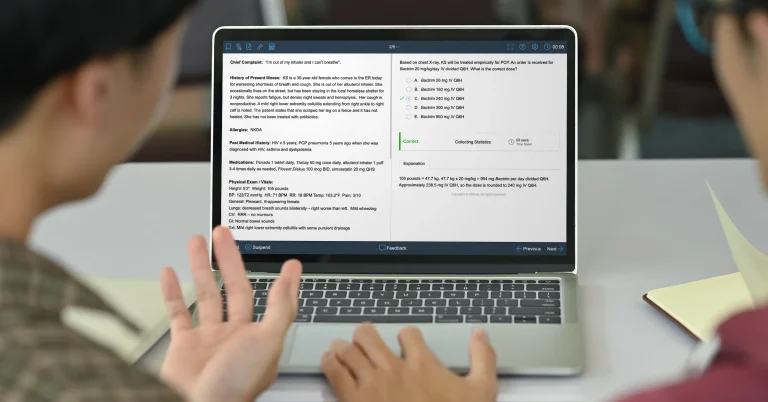The costs of pharmacy school are real, but so is the path to affording it. With the right information and support, you can make smart choices that keep your goals within reach. Being aware of all potential costs, not just tuition, helps you plan ahead, compare programs, minimize debt, and make informed decisions.
You’ve chosen a profession that’s challenging, rewarding, and makes a real difference and that decision deserves careful financial planning. Here’s guidance to help you understand what pharmacy school truly costs and how to manage those expenses.
Pharmacy School Costs in 2025
In 2025, most pharmacy students can expect to spend between $100,000 and $250,000 over the course of 4 years.1 The wide range in cost depends on several key factors such as whether a school is public or private, your residency status, the program’s length, and its geographic location.
Annual tuition at public pharmacy schools averages $34,000 for in-state students and $43,000 for out-of-state students. Private programs are more expensive, with some charging up to $92,000 annually.1 Some schools offer regional tuition discounts for students from neighboring states, which can reduce the total cost.2
In addition to core tuition, many programs charge extra fees for clinical rotations or experiential learning, especially in the final year. It’s important to note that billing structures vary. Some schools charge by credit hour, while others use a flat rate per academic year. Review how and when tuition and fees are applied as you compare programs.2
You’ll also need to account for mandatory fees, housing, food, books, transportation, health insurance, and personal expenses — all of which can significantly increase your total financial commitment.
To budget effectively, it’s important to look beyond the price of classes and consider everything from living expenses to insurance and transportation. In this section, we’ll break down both the average cost of tuition and the typical annual expenses pharmacy students can expect in 2025.
Pharmacy School Cost Per Year
Let’s look at what a full year of pharmacy school might actually cost, including tuition and all required living expenses, by using an estimation from Marshall University School of Pharmacy.
| Expense Category | Resident | Non-Resident |
|---|---|---|
| Annual Tuition & Fees | $24,614 | $40,386 |
| Books & Supplies | $1,150 | $1,150 |
| Program-Related Fees | $1,260 | $1,260 |
| Living Expenses | $13,050 | $13,050 |
| Computer | $2,000 | $2,000 |
| Transportation | $3,700 | $3,700 |
| Personal Expenses | $2,970 | $2,970 |
| Miscellaneous | $550 | $550 |
| Average Loan Fees* | $246 | $246 |
| Average Grad PLUS Fee* | $772 | $772 |
| Estimated Total | $49,540 | $65,312 |
Source: 5
*Loan-related fees only apply to federal student loans or Grad PLUS loans. Students who do not take out these loans will not incur these charges.
This example highlights how quickly the full cost of attendance can add up — even when tuition seems relatively affordable at first glance. However, don’t let this discourage you. Seeing the breakdown in advance allows you to plan proactively. Reviewing itemized costs like this can help you budget more accurately, understand your funding needs, and make informed decisions as you prepare for pharmacy school.
Factors Influencing Pharmacy School Costs
The cost of pharmacy school isn’t one-size-fits-all. Where you go, your residency status, and whether you attend a public or private institution can significantly affect your total expenses and long-term debt. Understanding these cost drivers early on will help you make informed choices and avoid unexpected financial pressure.
In-State vs. Out-of-State Tuition
One of the most significant cost differences comes down to where you live. Public pharmacy schools charge $34,000 on average, while out-of-state students pay $43,000 on average. Over 4 years, that can add up.
Your residency status is typically set at admission and often stays the same throughout the program. Some states allow you to establish residency after your first year, so it’s worth checking school policies. While tuition varies widely by residency, most other expenses, such as housing, books, and fees, will likely remain the same.
Tips for saving on out-of-state tuition
- Apply to in-state schools first to take advantage of lower tuition rates.
- Check for regional tuition agreements. Some schools offer reduced rates to students from neighboring states.
- Understand residency rules early in case you can reclassify after your first year.
- Compare total 4-year costs, not just year 1. Out-of-state tuition adds up quickly.
- Ask admissions offices directly if residency can be changed mid-program. Some schools may have flexibility or case-by-case exceptions.
Private vs. Public Pharmacy Schools
Private pharmacy schools typically charge between $30,000 and $92,000 per year, regardless of where you live.4 While some offer strong academic support or specialized programs, they’re often located in higher-cost urban areas, which can significantly increase your total attendance cost.
It’s not uncommon for students at private schools to graduate with $200,000 to $300,000 in debt — especially if they rely heavily on loans.6 That said, private institutions may also offer larger institutional scholarships or merit-based aid.7 Ask for the average aid package and consider your net cost, not just the sticker price.
Tips for comparing public vs. private schools
- Don’t assume a higher price means a better education. Accreditation standards are the same.
- Use total cost of attendance (tuition, fees, cost of living) for a true apples-to-apples comparison.
- Ask about scholarships and average financial aid packages. Don’t rely on listed tuition alone.
- Research outcomes. Look into NAPLEX scores, job placement rates and average starting salaries for graduates.
- Speak with current students or alumni for real-world insight into cost, support, and ROI.
Most Affordable Pharmacy Schools
Tuition and total cost of attendance can vary dramatically between pharmacy programs. Some schools offer a more affordable path to your Pharm.D., especially for in-state students, while others carry a significantly higher price tag.
Below is a curated list of pharmacy schools organized by estimated 4-year in-state and out-of-state tuition costs based on current and previous years across multiple sources.8 These figures reflect tuition only and do not include housing, books, fees, or other personal expenses. Always refer to each school’s official website for the most up-to-date details.
| School Name | In-State Tuition (4-Year Total) | Out-of-State Tuition (4-Year Total) |
|---|---|---|
| Florida A&M University | $20,764 | $74,772 |
| University of Montana | $46,732 | $92,248 |
| Texas A&M – Kingsville | $30,528 | $190,368 |
| University of Connecticut | $47,992 | $136,264 |
| Texas Tech University | $53,820 | $99,060 |
| University of Wyoming | $60,792 | $128,656 |
| University of South Florida | $66,440 | $66,440 |
| University of Texas at Austin | $67,176 | $173,648 |
| Rutgers University | $68,496 | $132,468 |
| University of Toledo | $69,456 | $119,960 |
| University of Georgia | $74,304 | $147,400 |
| Marshall University | $77,208 | $126,780 |
Source:8-19
*Tuition estimates are based on the most recent annual rates and multiplied across 4 academic years. Fees are not included. Always verify current rates with the institution directly.
If affordability is one of your top priorities, consider schools that consistently rank among the most cost-effective — especially for in-state students:
- Texas A&M at Kingsville, the University of Connecticut, and Texas Tech University all offer total in-state tuition under $60,000 across 4 years.
- While not the most affordable option overall, the University of South Florida offers the same tuition rate for in-state and out-of-state students, making it an affordable choice regardless of residency status.
While cost shouldn't be the only factor in your decision, these programs can be a strong starting point if you're trying to reduce your student debt while still receiving a quality education.
Comparing Pharmacy School Costs to Medical School
If you’re weighing your options between becoming a pharmacist or a physician, understanding the differences in cost can help you make an informed decision that fits your goals and budget.
Cost of Pharmacy School vs. Medical School
Pharmacy schools are generally less expensive than medical schools when you compare tuition and total program costs. Still, both paths come with a significant financial commitment.
The key difference often comes down to your long-term goals, how much training you're prepared for, and when you want to enter the workforce. As a pharmacy student, you’ll likely begin your career sooner. In contrast, medical students typically spend 3 to 7 years of residency training after graduation, which adds additional years of living expenses and delayed earning potential.20
Here's how pharmacy and medical school stack up in terms of tuition, program structure, and total estimated cost:
| Program | Average Tuition (Public, In-State) | Average Tuition (Private) | Total Estimated Cost (Professional Program Only) |
|---|---|---|---|
| Pharmacy School | $5,000-$30,000/year | $20,000-$95,000/year | $150,000-$250,000 |
| Medical School | $40,000-$60,000/year | $60,000-$100,000/year | $200,000-$350,000 |
Source:20
| Pathway | Undergraduate Prerequisites | Professional Program | Postgraduate Training | Total Years (Typical Range) |
|---|---|---|---|---|
| Pharmacy | 2-4 years (pre-pharmacy coursework or bachelor’s degree) | 4 years (Pharm.D.) | 0-2 years (optional residency/fellowship) | 6-8 years (licensure after Pharm.D.) |
| Medicine | 4 years (bachelor’s degree, pre-med) | 4 years (M.D. or D.O.) | 3-7+ years (required residency) | 11-15+ years (licensure after residency) |
Financial Aid and Scholarships for Pharmacy School
From national scholarships to school-specific aid and federal loans, various resources are available to help offset your expenses. The key is knowing where to look, what you're eligible for, and how to apply early enough to make the most of what’s offered.
Pharmacy School Scholarships in 2025
Scholarships are a great way to reduce your out-of-pocket costs. Unlike loans, they don’t have to be repaid. Many are based on academic performance, financial need, leadership, and a commitment to serving others. Below are a few notable options.
- APhA Foundation Student Scholarship Program: Recognizes students for academic achievement, leadership, and involvement in APhA–ASP chapters. In 2025, 27 pharmacy students received these awards.
- CVS Health / AACP Community Pharmacy Award: Offers $20,000 scholarships to 21 students annually. To qualify, you must be enrolled in a Pharm.D. program, have a GPA of at least 2.5, demonstrate financial need, and commit to underserved communities. Applications for this academic year are due June 1, 2025, and can be found on the CVS Health website.
- Tylenol Future Care Scholarship: Open to students pursuing healthcare careers, including pharmacy, medicine, and nursing. This scholarship awards up to $10,000 to pharmacy students and other healthcare fields and will be open through August 2025.
- Gateway Research Scholarship: Offers up to $5,000 for students engaged in research projects. The stipend is distributed in June of the recipient’s awarded year.
- Phi Lambda Sigma First Year Graduate Scholarship: A $10,000 scholarship awarded to Phi Lambda Sigma members in the final year of their Pharm.D. program who plan to pursue a Ph.D. in a college of pharmacy graduate program. This scholarship is not intended for general Pharm.D. students, but explicitly supports those transitioning into academic research through a pharmacy-focused PhD program.
Financial Aid Options
- Grants: These are usually awarded based on financial need. While limited at the graduate level, some state and institutional grants may still be available.
- Federal Loans: You can borrow up to $28,500 annually in Direct Unsubsidized Loans. If your cost of attendance exceeds that, you can also apply for Graduate PLUS Loans, which cover any remaining need.
- Private Loans: Offered by banks or credit unions, these often require a credit check and may have higher interest rates than federal options.
- Financial Aid Packages: Most schools provide a combination of loans, scholarships, and work-study opportunities. Be sure to complete the FAFSA as early as possible to determine your eligibility for federal loans and for any school-based aid or scholarships that consider financial need.
How to Save Money in Pharmacy School
Pharmacy school is a major investment, but there are plenty of smart ways to keep your costs down while still getting the education and training you need. With thoughtful planning and a few strategic habits, you can reduce your overall expenses, avoid unnecessary debt, and set yourself up for financial success after graduation.
Tips for Reducing Pharmacy School Expenses
Here are a few practical ways to cut costs and stay financially grounded while you work toward your Pharm.D.
- Choose more affordable housing options, such as living with roommates or staying at home if possible.
- Use public transportation, campus shuttles, or bike to class to cut transportation costs.
- Limit discretionary spending by meal prepping, using student discounts, and avoiding impulse purchases.
- Create a monthly budget and stick to it. Categorize your spending to see where you can cut back.
- Buy used textbooks, rent them, or opt for digital versions.
- Take advantage of campus resources, such as student health centers and free printing, when available.
- Research scholarships through your school, state associations, and national pharmacy organizations.
- Tailor each application to the scholarship’s requirements, and don’t miss deadlines.
- Keep a folder of key documents (transcripts, personal statements, letters of recommendation) ready to reuse and customize.
Saving during pharmacy school isn’t just about cutting corners — it’s about making thoughtful choices that allow you to focus on learning while protecting your future financial health. A huge aspect of planning for pharmacy school is understanding what it will cost, what support is available, and how to make decisions that set you up for long-term success.
The more informed you are now, the more confident you’ll feel later. Whether you’re mapping out your budget, applying for aid, or deciding which exam prep tools to invest in down the line, every choice you make is part of building a future you’ve worked hard for.
References
- Inspira Advantage. (n.d.). How much does pharmacy school cost? Retrieved from
https://www.inspiraadvantage.com/blog/how-much-does-pharmacy-school-cost - National Association of Student Financial Aid Administrators (NASFAA). (n.d.). State & regional tuition
exchanges. Retrieved from
https://www.nasfaa.org/State_Regional_Tuition_Exchanges - University of Maryland, Baltimore County (UMBC). (n.d.). Direct loan limits. Retrieved from
https://financialaid.umbc.edu/types-of-aid/federal-loans/direct-loan-limits/ - American Association of Colleges of Pharmacy (AACP). (n.d.). 2024-25 Tuition and Fees at U.S. Colleges and
Schools of Pharmacy Retrieved from
https://public.tableau.com/app/profile/aacpdata/viz/2024-25TuitionandFeesatU_S_CollegesandSchoolsofPharmacy/TuitionandFeesDashboard - Marshall University. (n.d.-a). Doctor of Pharmacy COA budgets. Retrieved from
https://www.marshall.edu/sfa/cost-of-attendance/doctor-of-pharmacy-coa-budgets/ - LendEDU. (n.d.). Average pharmacist student loan debt. Retrieved from
https://lendedu.com/blog/average-pharmacist-student-loan-debt/ - American Association of Colleges of Pharmacy (AACP). (n.d.-b). Financial aid and scholarships.
Retrieved from
https://www.aacp.org/resource/financial-aid-and-scholarships - LendingTree. (n.d.). Cheapest pharmacy schools. Retrieved from
https://www.lendingtree.com/student/cheapest-pharmacy-schools/ - Florida Agricultural and Mechanical University (FAMU). (n.d.). Tuition and fees. Retrieved from
https://www.famu.edu/academics/all-programs/pharmacy/doctor-of-pharmacy-pharmd.php - The University of Montana. (n.d.). Tuition. Retrieved from
https://www.umt.edu/academics/programs/pharmacy/ - University of Connecticut. (n.d.). Tuition & fees. Retrieved from
https://pharmacy.uconn.edu/ - Texas Tech University Health Sciences Center (TTUHSC). (n.d.). Pharmacy. Retrieved from
https://www.ttuhsc.edu/pharmacy/ - University of Wyoming. (n.d.). Pharmacy. Retrieved from
https://www.uwyo.edu/pharmacy/ - University of South Florida (USF). (n.d.). Tuition. Retrieved from
https://health.usf.edu/pharmacy/academics/pharmd/tuition - The University of Texas at Austin. (n.d.). Tuition & fees. Retrieved from
https://pharmacy.utexas.edu/admissions/doctor-of-pharmacy/tuition-fees - Rutgers, The State University of New Jersey. (n.d.). Tuition. Retrieved from
https://pharmacy.rutgers.edu/academics/doctor-of-pharmacy-pharmd/tuition/ - The University of Toledo. (n.d.). Tuition. Retrieved from
https://www.utoledo.edu/pharmacy/admissions/tuition.html - University of Georgia. (n.d.). Tuition and fees. Retrieved from
https://rx.uga.edu/doctor-of-pharmacy/how-to-apply/tuition-and-fees/ - Marshall University Joan C. Edwards School of Medicine (JCESOM). (n.d.-b). Pharmacy cost of
attendance. Retrieved from
https://jcesom.marshall.edu/students/financial-aid/cost-of-attendance/pharmacy-cost-of-attendance/ - American University of Antigua College of Medicine (AUA). (n.d.). Med school vs. pharmacy school.
Retrieved from
https://www.auamed.org/blog/med-school-vs-pharmacy-school/









